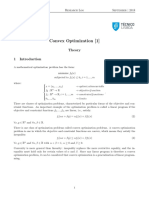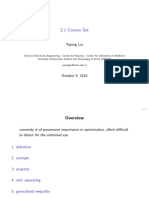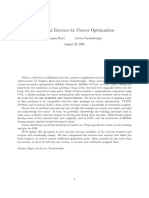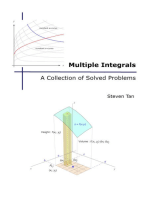convex_sets_functions
Uploaded by
Pratik Chatterjeeconvex_sets_functions
Uploaded by
Pratik ChatterjeeConvex set
line segment between x1 and x2: all points
x = ✓x1 + (1 ✓)x2
with 0 ✓ 1
convex set: contains line segment between any two points in the set
x1, x2 2 C, 0✓1 =) ✓x1 + (1 ✓)x2 2 C
examples (one convex, two nonconvex sets)
Convex sets 2–3
Convex combination and convex hull
convex combination of x1,. . . , xk : any point x of the form
x = ✓1 x1 + ✓2 x2 + · · · + ✓k xk
with ✓1 + · · · + ✓k = 1, ✓i 0
convex hull conv S: set of all convex combinations of points in S
Convex sets 2–4
Convex cone
conic (nonnegative) combination of x1 and x2: any point of the form
x = ✓1 x1 + ✓2 x2
with ✓1 0, ✓2 0
x1
x2
0
convex cone: set that contains all conic combinations of points in the set
Convex sets 2–5
Hyperplanes and halfspaces
hyperplane: set of the form {x | aT x = b} (a 6= 0)
a
x0
x
aT x = b
halfspace: set of the form {x | aT x b} (a 6= 0)
a
x0 aT x b
aT x b
• a is the normal vector
• hyperplanes are affine and convex; halfspaces are convex
Convex sets 2–6
Euclidean balls and ellipsoids
(Euclidean) ball with center xc and radius r:
B(xc, r) = {x | kx xck2 r} = {xc + ru | kuk2 1}
ellipsoid: set of the form
{x | (x xc ) T P 1
(x xc) 1}
with P 2 Sn++ (i.e., P symmetric positive definite)
xc
other representation: {xc + Au | kuk2 1} with A square and nonsingular
Convex sets 2–7
Convex Functions
Definition
f : Rn ! R is convex if dom f is a convex set and
f (✓x + (1 ✓)y) ✓f (x) + (1 ✓)f (y)
for all x, y 2 dom f , 0 ✓ 1
(y, f (y))
(x, f (x))
• f is concave if f is convex
• f is strictly convex if dom f is convex and
f (✓x + (1 ✓)y) < ✓f (x) + (1 ✓)f (y)
for x, y 2 dom f , x 6= y, 0 < ✓ < 1
Convex functions 3–2
Examples on R
convex:
• affine: ax + b on R, for any a, b 2 R
• exponential: eax, for any a 2 R
• powers: x↵ on R++, for ↵ 1 or ↵ 0
• powers of absolute value: |x|p on R, for p 1
• negative entropy: x log x on R++
concave:
• affine: ax + b on R, for any a, b 2 R
• powers: x↵ on R++, for 0 ↵ 1
• logarithm: log x on R++
Convex functions 3–3
Examples on Rn and Rm⇥n
affine functions are convex and concave; all norms are convex
examples on Rn
• affine function f (x) = aT x + b
Pn
• norms: kxkp = ( i=1 |xi|p)1/p for p 1; kxk1 = maxk |xk |
examples on Rm⇥n (m ⇥ n matrices)
• affine function
m X
X n
f (X) = tr(AT X) + b = Aij Xij + b
i=1 j=1
• spectral (maximum singular value) norm
T
f (X) = kXk2 = max (X) =( max (X X))1/2
Convex functions 3–4
First-order condition
f is di↵erentiable if dom f is open and the gradient
✓ ◆
@f (x) @f (x) @f (x)
rf (x) = , ,...,
@x1 @x2 @xn
exists at each x 2 dom f
1st-order condition: di↵erentiable f with convex domain is convex i↵
f (y) f (x) + rf (x)T (y x) for all x, y 2 dom f
f (y)
f (x) + rf (x)T (y x)
(x, f (x))
first-order approximation of f is global underestimator
Convex functions 3–7
Second-order conditions
f is twice di↵erentiable if dom f is open and the Hessian r2f (x) 2 Sn,
2 @ 2f (x)
r f (x)ij = , i, j = 1, . . . , n,
@xi@xj
exists at each x 2 dom f
2nd-order conditions: for twice di↵erentiable f with convex domain
• f is convex if and only if
r2f (x) ⌫ 0 for all x 2 dom f
• if r2f (x) 0 for all x 2 dom f , then f is strictly convex
Convex functions 3–8
Examples
quadratic function: f (x) = (1/2)xT P x + q T x + r (with P 2 Sn)
rf (x) = P x + q, r2f (x) = P
convex if P ⌫ 0
least-squares objective: f (x) = kAx bk22
rf (x) = 2AT (Ax b), r2f (x) = 2AT A
convex (for any A)
quadratic-over-linear: f (x, y) = x2/y 2
f (x, y)
T 1
2 y y
r2f (x, y) = 3 ⌫0
y x x 0
2 2
1 0
convex for y > 0 y 0 2 x
Convex functions 3–9
Jensen’s inequality
basic inequality: if f is convex, then for 0 ✓ 1,
f (✓x + (1 ✓)y) ✓f (x) + (1 ✓)f (y)
extension: if f is convex, then
f (E z) E f (z)
for any random variable z
basic inequality is special case with discrete distribution
prob(z = x) = ✓, prob(z = y) = 1 ✓
Convex functions 3–12
Operations that preserve convexity
practical methods for establishing convexity of a function
1. verify definition (often simplified by restricting to a line)
2. for twice di↵erentiable functions, show r2f (x) ⌫ 0
3. show that f is obtained from simple convex functions by operations
that preserve convexity
• nonnegative weighted sum
• composition with affine function
• pointwise maximum and supremum
• composition
• minimization
• perspective
Convex functions 3–13
Positive weighted sum & composition with affine function
nonnegative multiple: ↵f is convex if f is convex, ↵ 0
sum: f1 + f2 convex if f1, f2 convex (extends to infinite sums, integrals)
composition with affine function: f (Ax + b) is convex if f is convex
examples
• log barrier for linear inequalities
m
X
f (x) = log(bi aTi x), dom f = {x | aTi x < bi, i = 1, . . . , m}
i=1
• (any) norm of affine function: f (x) = kAx + bk
Convex functions 3–14
Pointwise maximum
if f1, . . . , fm are convex, then f (x) = max{f1(x), . . . , fm(x)} is convex
examples
• piecewise-linear function: f (x) = maxi=1,...,m(aTi x + bi) is convex
• sum of r largest components of x 2 Rn:
f (x) = x[1] + x[2] + · · · + x[r]
is convex (x[i] is ith largest component of x)
proof:
f (x) = max{xi1 + xi2 + · · · + xir | 1 i1 < i2 < · · · < ir n}
Convex functions 3–15
Composition with scalar functions
composition of g : Rn ! R and h : R ! R:
f (x) = h(g(x))
g convex, h convex, h̃ nondecreasing
f is convex if
g concave, h convex, h̃ nonincreasing
• proof (for n = 1, di↵erentiable g, h)
f 00(x) = h00(g(x))g 0(x)2 + h0(g(x))g 00(x)
• note: monotonicity must hold for extended-value extension h̃
examples
• exp g(x) is convex if g is convex
• 1/g(x) is convex if g is concave and positive
Convex functions 3–17
You might also like
- Additional Exercises For Convex OptimizationNo ratings yetAdditional Exercises For Convex Optimization116 pages
- SAP ABAP - Quick Guide - TutorialspointNo ratings yetSAP ABAP - Quick Guide - Tutorialspoint126 pages
- Convexity I: Sets and Functions: Ryan Tibshirani Convex Optimization 10-725No ratings yetConvexity I: Sets and Functions: Ryan Tibshirani Convex Optimization 10-72527 pages
- CS599: Convex and Combinatorial Optimization Fall 2013 Lectures 5-6: Convex FunctionsNo ratings yetCS599: Convex and Combinatorial Optimization Fall 2013 Lectures 5-6: Convex Functions55 pages
- Convex Optimization Overview: Zico Kolter October 19, 2007No ratings yetConvex Optimization Overview: Zico Kolter October 19, 200712 pages
- Additional Exercises For Convex Optimization PDFNo ratings yetAdditional Exercises For Convex Optimization PDF187 pages
- Convex Functions: 3.1 First AcquaintanceNo ratings yetConvex Functions: 3.1 First Acquaintance36 pages
- Additional Exercises For Convex Optimization: Stephen Boyd Lieven Vandenberghe March 30, 2012No ratings yetAdditional Exercises For Convex Optimization: Stephen Boyd Lieven Vandenberghe March 30, 2012143 pages
- Convexity and Optimization: 1 An Entirely Too Brief MotivationNo ratings yetConvexity and Optimization: 1 An Entirely Too Brief Motivation22 pages
- Measuring Financial Inclusion - A Multidimensional Index 2No ratings yetMeasuring Financial Inclusion - A Multidimensional Index 240 pages
- Performance Enhancement of Low Pressure Turbine Cascade by Introducing Tubercles100% (1)Performance Enhancement of Low Pressure Turbine Cascade by Introducing Tubercles7 pages
- Properties of Malaysian Fired Clay Bricks and Their Evaluation With International Masonry Specifications0% (1)Properties of Malaysian Fired Clay Bricks and Their Evaluation With International Masonry Specifications229 pages
- Deep Learning in C# - Understanding Neural Network Architecture - CodeProjectNo ratings yetDeep Learning in C# - Understanding Neural Network Architecture - CodeProject4 pages
- 8.05 Quadrilaterals Built From Triangles - WorksheetNo ratings yet8.05 Quadrilaterals Built From Triangles - Worksheet7 pages
- Impact of ROM PSD in Crushing and Grinding Circuit Throughput FinalNo ratings yetImpact of ROM PSD in Crushing and Grinding Circuit Throughput Final10 pages
- Quantum Field Theory A Diagrammatic Approach 1st Edition Ronald Kleiss pdf download100% (1)Quantum Field Theory A Diagrammatic Approach 1st Edition Ronald Kleiss pdf download34 pages
- Btech Eee 3 Sem Electrical Machines 1 76465 Jan 2021No ratings yetBtech Eee 3 Sem Electrical Machines 1 76465 Jan 20212 pages
- Indore Branch of Circ of Icai: Mr. Saurabh ParikhNo ratings yetIndore Branch of Circ of Icai: Mr. Saurabh Parikh32 pages
- Bulletin 627 Bureau of Mines Flammability of Combustible GAs and VaporsNo ratings yetBulletin 627 Bureau of Mines Flammability of Combustible GAs and Vapors130 pages
- Perceptual and Emotional Effects of Light and Color in A Simulatedretail SpaceNo ratings yetPerceptual and Emotional Effects of Light and Color in A Simulatedretail Space12 pages
- Three-And Four-Point Method: Resistance MeasurementsNo ratings yetThree-And Four-Point Method: Resistance Measurements8 pages
- Engineering Data: Heat Pump Outdoor UnitNo ratings yetEngineering Data: Heat Pump Outdoor Unit10 pages
- 77 TOP Electric Traction - Electrical Engineering Multiple Choice Questions and Answers - MCQs Preparation For Engineering Competitive Exams50% (2)77 TOP Electric Traction - Electrical Engineering Multiple Choice Questions and Answers - MCQs Preparation For Engineering Competitive Exams8 pages
- Engineering Failure Analysis: SciencedirectNo ratings yetEngineering Failure Analysis: Sciencedirect20 pages
- NUR HUSNA BINTI MOHD MAZLAN Moe - GC Chemical BondNo ratings yetNUR HUSNA BINTI MOHD MAZLAN Moe - GC Chemical Bond2 pages
- Convexity I: Sets and Functions: Ryan Tibshirani Convex Optimization 10-725Convexity I: Sets and Functions: Ryan Tibshirani Convex Optimization 10-725
- CS599: Convex and Combinatorial Optimization Fall 2013 Lectures 5-6: Convex FunctionsCS599: Convex and Combinatorial Optimization Fall 2013 Lectures 5-6: Convex Functions
- Convex Optimization Overview: Zico Kolter October 19, 2007Convex Optimization Overview: Zico Kolter October 19, 2007
- Additional Exercises For Convex Optimization: Stephen Boyd Lieven Vandenberghe March 30, 2012Additional Exercises For Convex Optimization: Stephen Boyd Lieven Vandenberghe March 30, 2012
- Convexity and Optimization: 1 An Entirely Too Brief MotivationConvexity and Optimization: 1 An Entirely Too Brief Motivation
- Transformation of Axes (Geometry) Mathematics Question BankFrom EverandTransformation of Axes (Geometry) Mathematics Question Bank
- A-level Maths Revision: Cheeky Revision ShortcutsFrom EverandA-level Maths Revision: Cheeky Revision Shortcuts
- Multiple Integrals, A Collection of Solved ProblemsFrom EverandMultiple Integrals, A Collection of Solved Problems
- Shortcuts to College Calculus Refreshment KitFrom EverandShortcuts to College Calculus Refreshment Kit
- Measuring Financial Inclusion - A Multidimensional Index 2Measuring Financial Inclusion - A Multidimensional Index 2
- Performance Enhancement of Low Pressure Turbine Cascade by Introducing TuberclesPerformance Enhancement of Low Pressure Turbine Cascade by Introducing Tubercles
- Properties of Malaysian Fired Clay Bricks and Their Evaluation With International Masonry SpecificationsProperties of Malaysian Fired Clay Bricks and Their Evaluation With International Masonry Specifications
- Deep Learning in C# - Understanding Neural Network Architecture - CodeProjectDeep Learning in C# - Understanding Neural Network Architecture - CodeProject
- 8.05 Quadrilaterals Built From Triangles - Worksheet8.05 Quadrilaterals Built From Triangles - Worksheet
- Impact of ROM PSD in Crushing and Grinding Circuit Throughput FinalImpact of ROM PSD in Crushing and Grinding Circuit Throughput Final
- Quantum Field Theory A Diagrammatic Approach 1st Edition Ronald Kleiss pdf downloadQuantum Field Theory A Diagrammatic Approach 1st Edition Ronald Kleiss pdf download
- Btech Eee 3 Sem Electrical Machines 1 76465 Jan 2021Btech Eee 3 Sem Electrical Machines 1 76465 Jan 2021
- Bulletin 627 Bureau of Mines Flammability of Combustible GAs and VaporsBulletin 627 Bureau of Mines Flammability of Combustible GAs and Vapors
- Perceptual and Emotional Effects of Light and Color in A Simulatedretail SpacePerceptual and Emotional Effects of Light and Color in A Simulatedretail Space
- Three-And Four-Point Method: Resistance MeasurementsThree-And Four-Point Method: Resistance Measurements
- 77 TOP Electric Traction - Electrical Engineering Multiple Choice Questions and Answers - MCQs Preparation For Engineering Competitive Exams77 TOP Electric Traction - Electrical Engineering Multiple Choice Questions and Answers - MCQs Preparation For Engineering Competitive Exams
- NUR HUSNA BINTI MOHD MAZLAN Moe - GC Chemical BondNUR HUSNA BINTI MOHD MAZLAN Moe - GC Chemical Bond

























































































